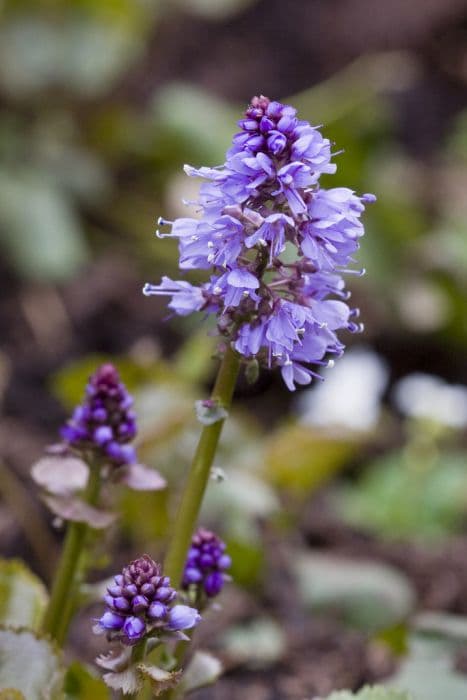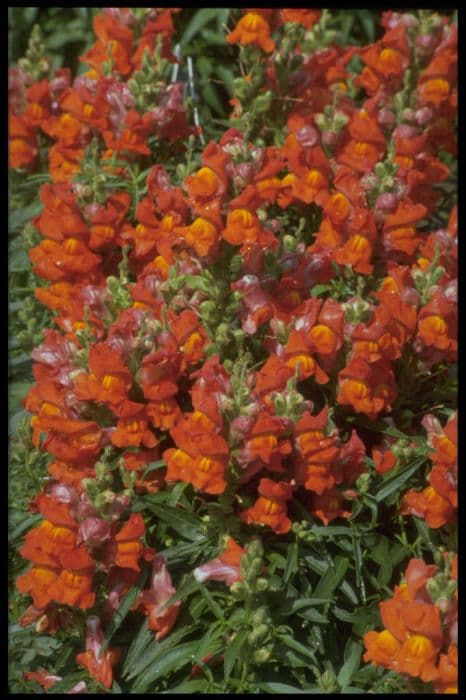Rocky Mountain kittentails Synthyris missurica

ABOUT
Synthyris missurica, commonly known as the Rocky Mountain kittentails, is characterized by a striking appearance that starts with its foliage. The leaves of this plant are mostly basal, which means they grow at the base of the stem. These leaves are heart-shaped and can have a deep green hue, often boasting a slightly hairy or fuzzy texture. As spring progresses, the plant produces flowering stems that are topped with spikes of tiny, tubular flowers. The flowers are an interesting feature of the Rocky Mountain kittentails, typically blue to violet in color, and they are densely packed along the spike, resembling a bottlebrush or a cat's tail, hence the name kittentails. These flowering spikes add a splash of color to the landscape and can be a unique point of interest in a garden setting. The overall presentation of the Rocky Mountain kittentails makes it an attractive plant for those who appreciate subtle woodland beauty.
About this plant
 Names
NamesFamily
Plantaginaceae
Synonyms
Rocky Mountain Kittentails, Missouri Kittentails, Spring Kittentails
Common names
Synthyris missurica.
 Toxicity
ToxicityTo humans
The plant Synthyris missurica, commonly known as Mountain Kittentail, is not widely reported as a toxic plant to humans. There is limited information available on the toxicity of this specific plant, and it does not appear to be listed among commonly known toxic plants. Therefore, there may be no significant toxicity to humans, but as with any plant, it is always wise to exercise caution and avoid ingesting parts of plants that are not known to be edible. If you suspect poisoning from any plant, it is important to consult a medical professional.
To pets
The plant Synthyris missurica, commonly known as Mountain Kittentail, is also not widely reported as a toxic plant to pets. There is a lack of specific information on its toxicity to domestic animals such as dogs and cats. It does not appear in the list of plants commonly known to be toxic to pets. However, as there is limited information, it is prudent to prevent pets from ingesting plants that are not confirmed to be safe. If you suspect your pet has ingested part of this plant and is showing signs of illness, consult a veterinarian.
 Characteristics
CharacteristicsLife cycle
Perennials
Foliage type
Deciduous
Color of leaves
Green
Flower color
Blue
Height
0.5 feet (15 cm)
Spread
0.5 feet (15 cm)
Plant type
Herb
Hardiness zones
4
Native area
North America
Benefits
 General Benefits
General Benefits- Ecosystem Support: Synthyris missurica, commonly known as Rocky Mountain kitty toes, provides nourishment and habitat to a variety of wildlife, supporting biodiversity.
- Pollinator Attraction: The plant blooms with flowers that attract bees, butterflies, and other pollinating insects, essential for ecosystem health.
- Erosion Control: Rocky Mountain kitty toes can help stabilize soil and prevent erosion due to their root structure.
- Aesthetics: With its attractive foliage and flowers, it contributes to the natural beauty of gardens and wild areas.
- Low Maintenance: Being a native wildflower, it typically requires less care compared to non-native ornamentals, making it an easy addition to low-maintenance landscapes.
- Drought Resistance: Suited to its native environment, it is often resilient to drought, reducing the need for irrigation in arid regions.
- Heritage Preservation: Planting native species like Synthyris missurica helps preserve the region's botanical heritage and maintains natural plant communities.
 Medical Properties
Medical PropertiesThis plant is not used for medical purposes.
 Air-purifying Qualities
Air-purifying QualitiesThis plant is not specifically known for air purifying qualities.
 Other Uses
Other Uses- Rock garden aesthetics: Kitty Clover is frequently utilized in rock gardens for its low-growing habit and attractive foliage, adding texture and color variation among stones and boulders.
- Erosion control: Due to its mat-forming nature, Kitty Clover can be planted on slopes or areas prone to erosion to help hold soil in place with its root system.
- Education and research: Kitty Clover offers a living example of plant adaptation and evolution for educational purposes in botanical gardens and university settings.
- Butterfly garden component: The flowers of Kitty Clover can attract butterflies and other pollinators, making it a suitable addition to butterfly gardens.
- Ground cover: Its dense growth can provide an attractive ground cover in garden beds, reducing the need for mulching and weed control.
- Photography subject: The vibrant flowers and foliage of Kitty Clover offer photographers a subject for macro and nature photography, especially in the spring.
- Border planting: Kitty Clover can be used to define edges and borders in a garden setting because of its compact growth habit.
- Ecological restoration: This plant might be used in projects that aim to restore native plant communities due to its place in certain regional ecosystems.
- Creative crafts: Dried flowers and leaves of Kitty Clover can be used in creating natural art, such as pressed flower crafts or botanical prints.
- Culinary presentation: While not widely known as an edible, Kitty Clover flowers could be used as a decorative, non-toxic garnish for culinary dishes.
Interesting Facts
 Feng Shui
Feng ShuiSynthyris missurica, commonly known as spring kitty tails, is not used in Feng Shui practice.
 Zodiac Sign Compitability
Zodiac Sign CompitabilitySpring kitty tails is not used in astrology practice.
 Plant Symbolism
Plant Symbolism- Rarity: Synthyris missurica, commonly known as Mountain Kittentails, is uncommon and not widely known, symbolizing uniqueness and the value of rare beauty in the world.
- Isolation: As a plant that thrives in mountainous regions, it often symbolizes solitude and the ability to flourish independently.
- Resilience: Mountain Kittentails adapt to challenging environments, representing the ability to withstand adversity and maintain grace under pressure.
- Conservation: Due to its specialized habitat, it represents the importance of environmental conservation and the protection of natural habitats.
- Spring Awakening: Since it blooms early in the spring, it symbolizes new beginnings and the awakening of life after winter's dormancy.
 Water
WaterRocky Mountain kittentails prefer a consistent moisture level, but they are somewhat drought tolerant once established. Water them deeply once a week, providing about 1-2 gallons depending on weather conditions, ensuring that the soil remains moist but not waterlogged. During the growing season in spring and summer, you may need to water a bit more frequently, especially if they're planted in sunnier spots or if it's particularly hot and dry. Reduce the frequency of watering in the fall and water sparingly in winter, adjusting the amount based on rainfall to prevent the roots from rotting.
 Light
LightRocky Mountain kittentails thrive best in partial shade to full shade. They should be placed in a spot that receives bright but indirect light. Avoid exposing the plant to direct afternoon sun especially in hotter climates, as this can cause stress and leaf burn. The ideal location can be under the canopy of larger trees or on the north side of a building where it receives filtered sunlight or only morning sun.
 Temperature
TemperatureRocky Mountain kittentails are hardy and can tolerate a range of temperatures. They grow best in temperatures between 60°F and 75°F. These plants can survive minimum temperatures down to around 20°F and are generally resilient to frost once established. They do not thrive in extremes, so avoid placing them in locations where temperatures regularly exceed 85°F.
 Pruning
PruningPruning Rocky Mountain kittentails is generally done to remove dead or damaged foliage and to maintain a tidy appearance. Light pruning can be performed in early spring or autumn. It's not necessary to prune this plant aggressively; simply trim back the spent flowers after blooming and remove any dead leaves to encourage healthy growth and airflow.
 Cleaning
CleaningAs needed
 Soil
SoilRocky Mountain kittentails thrive in well-draining soil with a pH that's slightly acidic to neutral, around 6.0 to 7.0. The best soil mix should contain a combination of loam, peat, and sharp sand to facilitate drainage while retaining adequate moisture. Regular garden soil can be amended with these materials to achieve the desired texture and pH for optimal growth.
 Repotting
RepottingRocky Mountain kittentails do not require frequent repotting and can usually remain in the same pot for several years. Repotting every 2 to 3 years or when the plant has outgrown its current container is sufficient. Spring is the best time to repot to minimize stress on the plant.
 Humidity & Misting
Humidity & MistingRocky Mountain kittentails prefer moderate humidity levels but will tolerate a range of conditions as long as they are not in a constantly dry environment. Strive to maintain humidity levels around 40-60% for the healthiest growth, which is typically the average indoor humidity range.
 Suitable locations
Suitable locationsIndoor
Place Rocky Mountain kittentails in bright, indirect light.
Outdoor
Plant in partial shade with good drainage.
Hardiness zone
4-8 USDA
 Life cycle
Life cycleSynthyris missurica, commonly known as the Rocky Mountain kittentail, begins its life cycle with seed germination, typically occurring in moist soils in shady areas. Seedlings emerge in spring, developing a rosette of basal leaves that are heart-shaped at maturity. The plant then grows a flowering stalk, boasting small, deep blue to purple flowers arranged in racemes, primarily blooming from late spring to early summer. After pollination, often by insects, the flowers produce capsules containing seeds, which fall to the ground and enter a period of dormancy. The Rocky Mountain kittentail is a perennial, so once the above-ground parts die back in the winter, the plant survives underground as a rootstock, reemerging the following spring. This cycle of vegetative growth, flowering, seed production, and dormancy continues year after year.
 Propogation
PropogationPropogation time
Spring to early summer
Synthyris missurica, commonly known as the Rocky Mountain kittentail, can be effectively propagated from seed. The best time to sow the seeds is in late winter to early spring, after a period of cold stratification to break down the seed's dormancy. This imitates the natural chilling period that seeds would experience in the wild during winter. To propagate by seed, you should first mix the seeds with moist sand and store them in a refrigerator for about four to six weeks. Then, plant the seeds shallowly in a well-draining soil mix, ensuring that they are lightly covered. The soil should be kept moist but not wet, and placed in a bright, indirect light until germination occurs, which can take several weeks. After the seedlings have developed true leaves and are large enough to handle, they can be transplanted into individual pots or their final garden location.









